问题解决型作文常用句型
- 格式:doc
- 大小:35.00 KB
- 文档页数:3
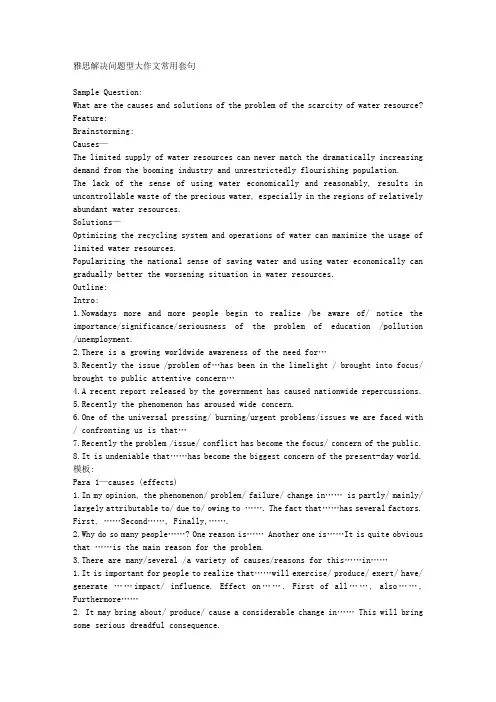
雅思解决问题型大作文常用套句Sample Question:What are the causes and solutions of the problem of the scarcity of water resource? Feature:Brainstorming:Causes—The limited supply of water resources can never match the dramatically increasing demand from the booming industry and unrestrictedly flourishing population.The lack of the sense of using water economically and reasonably, results in uncontrollable waste of the precious water, especially in the regions of relatively abundant water resources.Solutions—Optimizing the recycling system and operations of water can maximize the usage of limited water resources.Popularizing the national sense of saving water and using water economically can gradually better the worsening situation in water resources.Outline:Intro:1.Nowadays more and more people begin to realize /be aware of/ notice the importance/significance/seriousness of the problem of education /pollution /unemployment.2.There is a growing worldwide awareness of the need for…3.Recently the issue /problem of…has been in the limelight / brought into focus/ brought to public attentive concern…4.A recent report released by the government has caused nationwide repercussions.5.Recently the phenomenon has aroused wide concern.6.One of the universal pressing/ burning/urgent problems/issues we are faced with / confronting us is that…7.Recently the problem /issue/ conflict has become the focus/ concern of the public.8.It is undeniable that……has become the biggest concern of the present-day world. 模板:Para 1—causes (effects)1.In my opinion, the phenomenon/ problem/ failure/ change in…… is partly/ mainly/ largely attributable to/ due to/ owing to ……. The fact that……has several factors. First, ……Second……, Finally,…….2.Why do so many people……? One reason is…… Another one is……It is quite obvious that ……is the main reason for the problem.3.There are many/several /a variety of causes/reasons for this……in……1.It is important for people to realize that……will exercise/ produce/ exert/ have/ generate ……impact/ influence. Effect on……. First of all……, also……, Furthermore……2. It may bring about/ produce/ cause a considerable change in…… This will bring some serious dreadful consequence.Para 2—Solutions:1. It is urgent/ important/ necessary that appropriate/ effective/ proper actions/ measures/ steps/ method be taken to end/ correct/ improve…2. There are believed / expected / supposed to be two effective measures/ practical schemes/ sound solutions, one of which is…3.Both governments and ordinary citizens should join hands to make this world a better place to live in, not only for ourselves, but also for future generations.4.Measures must be taken to solve the problem……5.We must look for/ search for/ call for an immediate solution/ action/ method/ measure because the present/ current situation/ state of……If permitted to continue, it will surely/ certainly lead to/ result in the destruction/ the end of……6.It is suggested/ recommended/ hoped that continuous /great/ persistent efforts should be made to halt/control/check the dangerous growth/ increase of……Anyhow, wider education/ more publicity should be given to the serious possible potential / consequences/ effects ofConc:1.Taking into account all these factors, we may safely draw the conclusion that……It is time that we put/ placed / laid considerable special emphasis on the development/ change/ growth of……2.There is no denying/ little doubt that special/ adequate/ considerable/ further attention must be paid/ called / devoted to the problem of ……If we ignore/ fail in / are blind to the problem, it is very likely that……3.Obviously/ Clearly/ Apparently/ No doubt that there is very little chance that……unless there is an immediate action of/ common realization of……【。
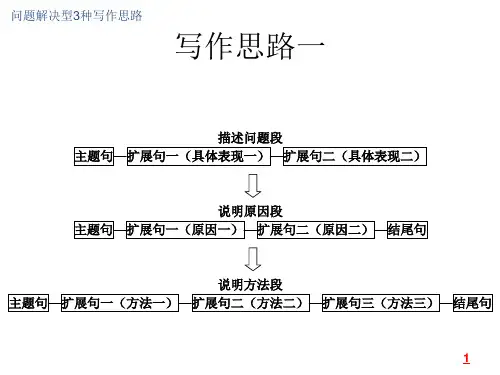
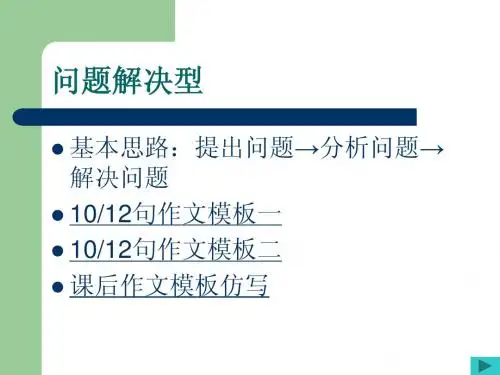
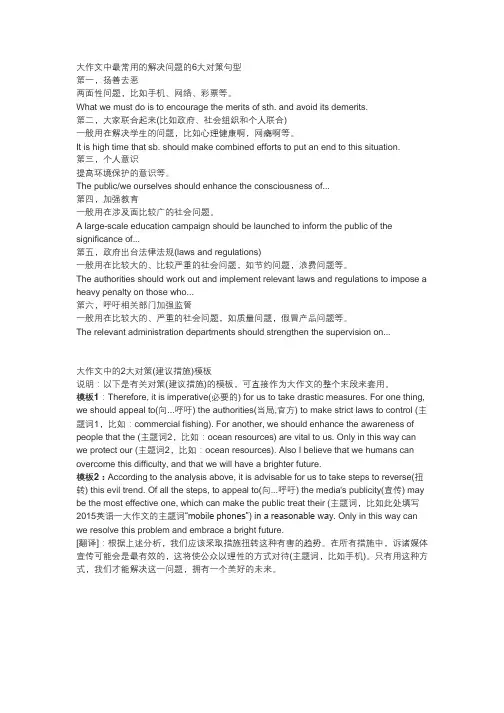
大作文中最常用的解决问题的6大对策句型第一,扬善去恶两面性问题,比如手机、网络、彩票等。
What we must do is to encourage the merits of sth. and avoid its demerits.第二,大家联合起来(比如政府、社会组织和个人联合)一般用在解决学生的问题,比如心理健康啊,网瘾啊等。
It is high time that sb. should make combined efforts to put an end to this situation.第三,个人意识提高环境保护的意识等。
The public/we ourselves should enhance the consciousness of...第四,加强教育一般用在涉及面比较广的社会问题。
A large-scale education campaign should be launched to inform the public of the significance of...第五,政府出台法律法规(laws and regulations)一般用在比较大的、比较严重的社会问题,如节约问题,浪费问题等。
The authorities should work out and implement relevant laws and regulations to impose a heavy penalty on those who...第六,呼吁相关部门加强监管一般用在比较大的、严重的社会问题,如质量问题,假冒产品问题等。
The relevant administration departments should strengthen the supervision on...大作文中的2大对策(建议措施)模板说明:以下是有关对策(建议措施)的模板,可直接作为大作文的整个末段来套用。
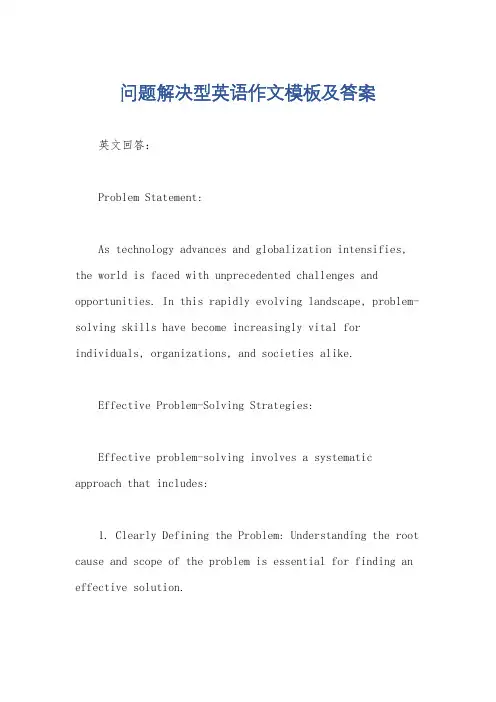
问题解决型英语作文模板及答案英文回答:Problem Statement:As technology advances and globalization intensifies, the world is faced with unprecedented challenges and opportunities. In this rapidly evolving landscape, problem-solving skills have become increasingly vital for individuals, organizations, and societies alike.Effective Problem-Solving Strategies:Effective problem-solving involves a systematic approach that includes:1. Clearly Defining the Problem: Understanding the root cause and scope of the problem is essential for finding an effective solution.2. Gathering Information: Collect relevant data, insights, and perspectives from various sources to gain a comprehensive understanding of the situation.3. Brainstorming Solutions: Generate a wide range of potential solutions, considering both traditional approaches and innovative ideas.4. Evaluating Solutions: Analyze the pros and cons of each solution, considering feasibility, effectiveness, and potential consequences.5. Selecting and Implementing a Solution: Choose the most appropriate solution and put it into action, monitoring progress and making adjustments as needed.6. Reflecting and Evaluating: Assess the effectiveness of the implemented solution and identify areas for improvement in future problem-solving efforts.Importance of Problem-Solving Skills:Problem-solving skills are indispensable in various aspects of life, including:Personal and Professional Development: They enable individuals to overcome obstacles, adapt to changing circumstances, and achieve their goals.Organizational Success: Problem-solving is essential for organizations to navigate challenges, improve efficiency, and foster innovation.Societal Progress: By addressing complex issues such as climate change, poverty, and inequality, problem-solving contributes to the well-being and advancement of societies.Enhancing Problem-Solving Abilities:To enhance problem-solving abilities, consider the following strategies:Develop Critical Thinking Skills: Analyze information, identify patterns, and draw logical conclusions.Foster Creativity: Embrace different perspectives, challenge assumptions, and generate innovative solutions.Practice Active Listening: Pay attention to others' ideas, perspectives, and concerns.Seek Feedback: Engage in constructive feedback loopsto identify areas for improvement and refine your solutions.Embrace Collaboration: Work with others to leverage diverse perspectives and expertise.Conclusion:In an era characterized by constant change and uncertainty, problem-solving skills are essential for navigating challenges, seizing opportunities, and creatinga better future. By adopting effective strategies,fostering critical thinking, and continuously refining our abilities, we can empower ourselves and our organizationsto address complex problems and drive progress for society.中文回答:问题解决型英语作文模板。
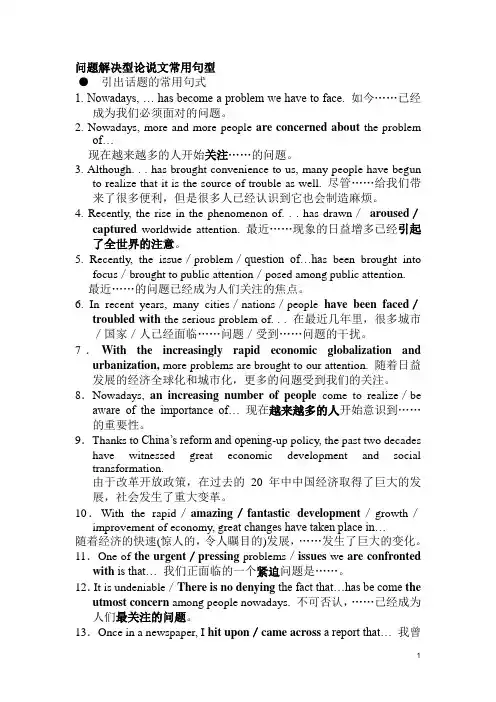
问题解决型论说文常用句型●引出话题的常用句式1. Nowadays, … has become a problem we have to face. 如今……已经成为我们必须面对的问题。
2. Nowadays, more and more people are concerned about the problemof…现在越来越多的人开始关注……的问题。
3. Although. . . has brought convenience to us, many people have begunto realize that it is the source of trouble as well. 尽管……给我们带来了很多便利,但是很多人已经认识到它也会制造麻烦。
4. Recently, the rise in the phenomenon of. . . has drawn/aroused/captured worldwide attention. 最近……现象的日益增多已经引起了全世界的注意。
5. Recently, the issue/problem/question of…ha s been brought intofocus/brought to public attention/posed among public attention.最近……的问题已经成为人们关注的焦点。
6. In recent years, many cities/nations/people have been faced/troubled with the serious problem of. . . 在最近几年里,很多城市/国家/人已经面临……问题/受到……问题的干扰。
7.With the increasingly rapid economic globalization and urbanization, more problems are brought to our attention. 随着日益发展的经济全球化和城市化,更多的问题受到我们的关注。
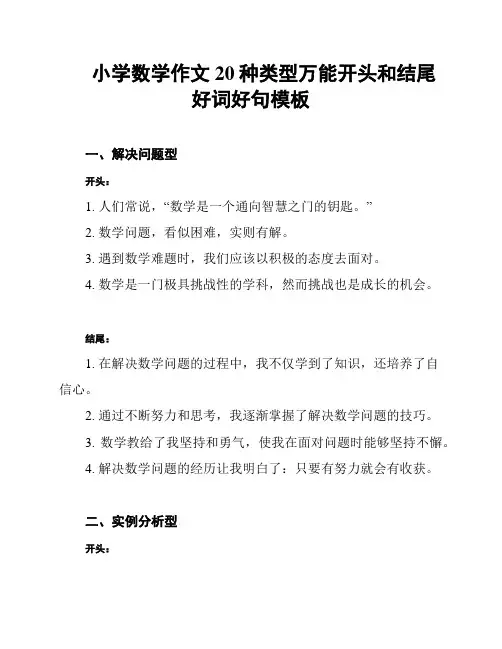
小学数学作文20种类型万能开头和结尾好词好句模板一、解决问题型开头:1. 人们常说,“数学是一个通向智慧之门的钥匙。
”2. 数学问题,看似困难,实则有解。
3. 遇到数学难题时,我们应该以积极的态度去面对。
4. 数学是一门极具挑战性的学科,然而挑战也是成长的机会。
结尾:1. 在解决数学问题的过程中,我不仅学到了知识,还培养了自信心。
2. 通过不断努力和思考,我逐渐掌握了解决数学问题的技巧。
3. 数学教给了我坚持和勇气,使我在面对问题时能够坚持不懈。
4. 解决数学问题的经历让我明白了:只要有努力就会有收获。
二、实例分析型开头:1. 数学就像一道迷宫,我将选择一道道数学题目作为钥匙,逐个地打开智慧的门。
2. 数学作为一种智力活动,是一门探索未知世界的重要工具。
3. 数学不仅仅是静静地坐在课桌前默默思考,它还处处融入着人们的生活。
结尾:1. 通过这个实例分析,我深刻地感受到了数学的力量和美妙。
2. 这个实例让我明白了数学不仅仅是考试的工具,更是我们认识世界的一扇窗户。
3. 通过实例的分析,我在数学中发现了智慧和趣味。
三、数学游戏型开头:1. 数学游戏是一种既能够学到知识又能够开心愉快的研究方式。
2. 数学可以做到既严肃又有趣,让我们来玩一个数学游戏吧!结尾:1. 在欢乐的数学游戏中,我发现了数学的乐趣,也培养了自己的思维能力。
2. 数学游戏不仅提高了我的计算能力,还让我充分体会到了团队协作的重要性。
四、数学在生活中的应用型开头:1. 数学不仅存在于课本中,还广泛地应用于我们的生活中。
2. 数学是一门实用的学科,它在日常生活中处处有用。
结尾:1. 数学的应用让我深刻地感受到它的魅力和重要性。
2. 通过这个例子,我明白了数学对我们的生活有着巨大的帮助。
五、数学启发型开头:1. 当我们研究数学的时候,其实在研究一种思维方式和解决问题的能力。
2. 数学不仅仅是解答问题的方法,更是一种培养我们思维能力的工具。
结尾:1. 数学的研究让我明白了思维的重要性,学会了用数学的方法思考问题。
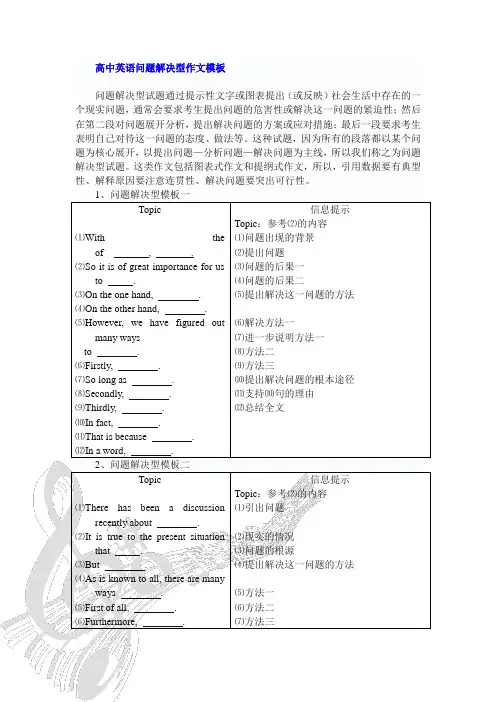
高中英语问题解决型作文模板问题解决型试题通过提示性文字或图表提出(或反映)社会生活中存在的一个现实问题,通常会要求考生提出问题的危害性或解决这一问题的紧迫性;然后在第二段对问题展开分析,提出解决问题的方案或应对措施;最后一段要求考生表明自己对待这一问题的态度、做法等。
这种试题,因为所有的段落都以某个问题为核心展开,以提出问题—分析问题—解决问题为主线,所以我们称之为问题解决型试题。
这类作文包括图表式作文和提纲式作文,所以,引用数据要有典型性、解释原因要注意连贯性、解决问题要突出可行性。
1、问题解决型模板一Topic⑴With theof , .⑵So it is of great importance for usto .⑶On the one hand, .⑷On the other hand, .⑸However, we have figured outmany waysto .⑹Firstly, .⑺So long as .⑻Secondly, .⑼Thirdly, .⑽In fact, .⑾That is because .⑿In a word, .信息提示Topic:参考⑵的内容⑴问题出现的背景⑵提出问题⑶问题的后果一⑷问题的后果二⑸提出解决这一问题的方法⑹解决方法一⑺进一步说明方法一⑻方法二⑼方法三⑽提出解决问题的根本途径⑾支持⑽句的理由⑿总结全文2、问题解决型模板二Topic⑴There has been a discussionrecently about .⑵It is true to the present situationthat .⑶But .⑷As is known to all, there are manyways .⑸First of all, .⑹Furthermore, .信息提示Topic:参考⑵的内容⑴引出问题⑵现实的情况⑶问题的根源⑷提出解决这一问题的方法⑸方法一⑹方法二⑺方法三⑺Last but not least, .⑻So it is high time for usto .⑼That is because .⑽Secondly, ..⑾Thirdly, .⑿All in all, .⑻提出解决这一问题的必要性⑼必要性的理由一⑽理由二⑾理由三⑿总结全文3、问题解决型模板三Topic⑴Nowadays, there is a growingconcerm on .⑵It is certain that .⑶However, .⑷It will cause many serious resultsif .⑸Firstly, .⑹Secondly, .⑺Finally, .⑻In spite of all these, there are stillmany ways .⑼First of all, .⑽In addition, ..⑾Thirdly, .⑿Only in this way, .信息提示Topic:参考⑷的内容⑴提出问题上⑵问题产生的背景⑶与背景有关的情况⑷问题产生的原因⑸原因一⑹原因二⑺原因三⑻解决这一问题的方法⑼方法一⑽方法二⑾方法三⑿指明前景。

英语作文问题解决类万能措施句式全文共6篇示例,供读者参考篇1How to Solve Any ProblemHi there! My name is Sam and I'm a 4th grader. I used to get really frustrated whenever I had a problem I couldn't solve. Whether it was a tough math worksheet, a fight with my friend, or losing my favorite toy, I would just get upset and give up. But then my teacher taught us some great strategies for solving problems, and now I feel like I can take on anything! Let me share my favorite tips with you.The first step is to take a deep breath and stay calm. When you're really mad or upset, it's hard to think clearly. So if you're feeling worked up, stop for a minute. Take some slow, deep breaths and count to 10. Getting yourself into a calmer state will help your brain work better so you can think through the problem.Next, you want to identify exactly what the problem is. Sometimes things seem confusing because we're not really sure what we're trying to solve. Break it down into a simple questionlike "How can I find the area of this rectangle?" or "Why is my friend mad at me?" Having a clear problem statement makes it much easier to start finding solutions.Once you know the problem, it's time to get your brain working on solutions! One of my favorite strategies is brainstorming. Just write down every idea that comes to mind, no matter how silly or impossible it seems at first. The more ideas the better! You can brainstorm on your own or withfriends/family. Sometimes the craziest ideas can spark a great solution.When you have a nice list of potential solutions, the next step is to evaluate each option. What are the pros and cons? Which solution seems most realistic and likely to work? You may need to do some research or experiments to figure out the best path forward. Don't be afraid to ask others for help or advice during this stage.After weighing your options, it's time to pick a solution and make a plan to carry it out. Break it down into step-by-step instructions so you know exactly what you need to do. It's kind of like following a recipe! Having a clear plan makes everything less overwhelming.As you work through your plan, it's important to stay flexible. Sometimes your first solution doesn't work out perfectly, and that's okay! You may need to circle back and try a different approach from your brainstorming list. The key is to keep persevering and not give up.Once you've solved the problem, take a minute to celebrate your success! You worked really hard and used greatproblem-solving skills. Pause to feel proud of yourself. It's also really important to analyze what went well and what you might do differently next time. Learning from each experience will make you an even better problem solver.Those are the basic steps, but let me give you some examples of how I've used this approach. Earlier this year, I was having trouble with area and perimeter in math class. No matter how many times my teacher explained it, I kept getting mixed up.So first, I wrote down precisely what I was having trouble with - finding the area of rectangles. Then I brainstormed a bunch of ideas like drawing pictures, using hands-on objects, watching videos, and more. I decided to try drawing grid models of the rectangles, since that's a visual strategy my teacher recommended.I made a plan for practicing area with grid models every night for two weeks. At first I kept making silly mistakes, but I didn't get discouraged. I just tried a different approach from my brainstorming list, like using actual square tiles to model the areas.Finally, after a bunch of practice and tweaking my strategies, it all started to click! I could visualize the areas much more clearly. On my next test, I got an A+. I was so proud and relieved to have worked through that problem.Another time, I got into an argument with my best friend Kyle about what game to play at recess. We were shouting and upset, and ended up not speaking to each other for a few days. After calming down, I realized our problem was that we both wanted to play different games, and we never considered any compromises.So I brainstormed ideas like taking turns picking games each day, playing for half the recess then switching, or finding a game we both enjoyed. I thought his mom might be able to help us decide on a fair solution too. Kyle and I agreed to try playing my game for the first half of recess, then switching to his game after. It wasn't perfect, but it was a compromise we were both willing to try.The next day, our plan worked pretty well! Sure, I got a little bored towards the end of Kyle's game. But at least we resolved the argument in a peaceful way and got to spend recess together again as friends. Problems between friends are never fun, but I'm glad I used strategies to work through it.As you can see, these problem-solving steps are pretty handy for all kinds of situations! Anytime you feel stuck or confused, just pause to identify the specific problem, brainstorm ideas, make a plan, and give it a try. If it doesn't work perfectly at first, no biggie! Just adjust your approach and keep working at it.I know these strategies might seem hard for bigger kid problems. But I've learned that even grown-ups use the same basic process to solve really complex issues at work, in their communities, and more. The ability to calmly work through challenges is an incredibly important skill that will help you your whole life.So don't get discouraged or give up easily. Whenever you're facing a problem big or small, use the strategies we just covered. Take deep breaths, clearly identify the issue, brainstorm many possible solutions, make a step-by-step plan, and persistently adjust your approach as needed. If you keep practicing, you'll become an amazing problem solver!Just remember to also celebrate your successes along the way. Developing into a problem-solving ninja takes hard work and patience. But it's one of the most valuable life skills you can develop. So keep at it, believe in yourself, and you can overcome any obstacle! Thanks for reading, and happy problem-solving!篇2Title: Solving Any Problem Like a Superhero!Have you ever felt stuck when facing a difficult problem? Don't worry, because with the right strategies, you can become a true problem-solving superhero! Whether it's a tricky math equation, a disagreement with a friend, or a challenging project, these steps will help you conquer any obstacle that comes your way.Step 1: Understand the ProblemThe first step to solving any problem is to fully understand what it is. Ask yourself questions like, "What exactly is the problem?" and "Why is it a problem?" Sometimes, just by breaking it down and thinking about it clearly, the solution may become obvious. If not, don't worry – there are plenty more steps to follow!Step 2: Gather InformationA superhero always does their research before taking action. Gather as much information as you can about the problemyou're trying to solve. Look for clues, ask questions, and learn from others who might have faced similar challenges. The more you know, the better equipped you'll be to find a solution.Step 3: Brainstorm IdeasNow it's time to put on your thinking cap and come up with as many ideas as possible. Don't worry about whether they're good or bad ideas – just let your creativity flow! Write down every idea that comes to mind, no matter how silly it might seem. Sometimes, the craziest ideas can lead to the most amazing solutions.Step 4: Evaluate Your OptionsOnce you have a list of potential solutions, it's time to evaluate each one. Think about the pros and cons of each idea. Which ones are realistic and achievable? Which ones might cause more problems than they solve? Cross off the ideas that won't work, and focus on the most promising ones.Step 5: Make a PlanNow that you've narrowed down your options, it's time to make a plan. Decide which solution you want to try first, and map out the steps you'll need to take to implement it. If it's a big problem, break it down into smaller, more manageable tasks. Remember, even superheroes need a well-thought-out plan of attack!Step 6: Take ActionIt's time to put your plan into action! But don't just charge in blindly – proceed with caution and be prepared to adjust your plan if needed. If your first solution doesn't work, don't get discouraged. Go back to your list of ideas and try another approach. Persistence is key!Step 7: Reflect and CelebrateOnce you've solved the problem (yay!), take a moment to reflect on what went well and what you might do differently next time. Learning from your experiences will make you an even better problem-solver in the future. And don't forget to celebrate your success – you've just proven that you're a true problem-solving superhero!Remember, every problem is an opportunity to learn and grow. By following these steps, you'll develop the skills andconfidence to tackle any challenge that comes your way. So embrace those problems, and get ready to save the day like a true superhero!篇3How to Solve Any ProblemHi there! My name is Jamie and I'm here to share some tips on how to solve any problem you might face. As a kid, I know there are lots of problems that can come up - trouble with homework, fights with friends, chores you don't want to do. But don't worry, I've got some tricks up my sleeve to help you out!The first step is to take a deep breath. When you get overwhelmed or upset, it's hard to think clearly. So pause for a moment and breathe slowly. In through your nose and out through your mouth. This will help calm you down so you can look at the problem with a clear head.Next, you need to identify exactly what the problem is. Sometimes issues can seem really big and confusing at first. Break it down into smaller pieces to understand what is really going on. Ask yourself questions like "What is the main thing I'm struggling with here?" or "What part of this do I need help with?"Once you know the specifics of the problem, it's time to start looking for solutions. Brainstorm as many ideas as you can, even ones that seem a little silly at first. Write them all down on a piece of paper. Don't judge any ideas yet, just let your creativity flow!When you have a good list of potential solutions, you can start evaluating them. Which ones seem realistic and possible for you to actually do? Cross off any that are clearly not going to work. For the remaining ideas, think about the pros and cons of each. You may want to ask a parent, teacher or trusted friend for their thoughts too.After careful consideration, pick one solution that seems like the best option. Make a plan for how you will put it into action. If it's a big task, break it down into smaller steps that you can follow. Decide what you need to get started and prepare yourself mentally.Then it's time to give your solution a try! As you work through it, pay attention to how it's going. If things aren't working out quite like you expected, don't get discouraged. Stay flexible and adjust your plan as needed. Or you may decide to abandon this solution and try a different one from your list.The most important thing is to not give up. Some problems are hard and may take multiple attempts before you crack the code. Stick with it, believe in yourself, and draw on your inner strength and resilience. You've got this!If you find yourself feeling stuck, don't be afraid to ask for help. Maybe you need some guidance or advice. Maybe you need someone to help do part of the task. There's no shame in that - we all need support sometimes. The key is being humble enough to recognize when you're in over your head.Once you've successfully solved the problem, take a moment to celebrate your awesomeness! You worked really hard and showed incredible determination and perseverance. Give yourself a high five or treat yourself to something fun.Then take a step back and reflect on what worked well and what didn't. What lessons did you learn that you can apply to future problems? Maybe you discovered that breaking tasks into chunks makes them easier. Or that it helps to walk away for a while if you're feeling frustrated. Keep these tips in mind for next time.I know problem-solving can be really hard, but I also know you've got what it takes to handle anything that comes your way.By following these strategies and believing in yourself, you'll be amazed at what you can accomplish!So don't be afraid of problems, be excited to tackle them head on! Every issue is a chance to grow and develop your skills. With patience, resilience and a positive attitude, you'll be a problem-solving superstar. I'm rooting for you!篇4Universal Strategies for Problem-SolvingHi there, friends! Today, I want to share with you some super awesome strategies that can help us solve all kinds of problems. Whether it's a tricky math question, a disagreement with a friend, or a big, hairy challenge, these strategies will be your trusty sidekicks. So, let's dive right in!Strategy #1: Stay Calm and Don't Panic!When we're faced with a problem, it's easy to feel overwhelmed and start freaking out. But you know what? Panicking never helps! It's like trying to put out a fire with gasoline – it only makes things worse. Instead, take a deep breath and remind yourself that every problem has a solution.Staying calm will help you think more clearly and approach the situation with a cool head.Strategy #2: Break It Down into Smaller PiecesSometimes, problems can seem so big and complicated that we don't even know where to start. That's when it's time to break it down into smaller, more manageable pieces. It's like trying to eat a massive burger – you don't shove the whole thing in your mouth at once! You take one bite at a time. Tackle each piece of the problem one step at a time, and before you know it, you'll have conquered the whole thing.Strategy #3: Ask for HelpYou know what they say – two heads are better than one! If you're stuck and can't figure out a solution, don't be afraid to ask for help. Your friends, family, or teachers might have a fresh perspective or some valuable insights that could help you crack the code. Plus, working together can make problem-solving a lot more fun and rewarding.Strategy #4: Think Outside the BoxSometimes, the obvious solutions just aren't cutting it. That's when you need to put on your creative thinking cap and come up with some out-of-the-box ideas. Don't be afraid to get a littlewacky or unconventional – some of the best solutions come from unexpected places. Who knows, maybe your crazy idea will turn out to be a stroke of genius!Strategy #5: Learn from Your MistakesGuess what? Making mistakes is totally okay – it's how we learn and grow! Instead of beating yourself up over a mistake, try to learn from it. Think about what went wrong and what you could do differently next time. Every mistake is an opportunity to improve and become a better problem-solver.Strategy #6: Celebrate Your SuccessesWhenever you successfully solve a problem, no matter how big or small, give yourself a pat on the back! Celebrate your accomplishments and take pride in your hard work. Recognizing your successes will give you the confidence and motivation to tackle even bigger challenges in the future.Strategy #7: Never Give UpSometimes, problems can be really tough and stubborn. You might feel like giving up, but don't! Keep trying different strategies and approaches until you find one that works. Remember, every problem has a solution, and if you persevere,you'll eventually crack the code. Giving up is the only real failure, so keep pushing forward!Phew, that's a lot of awesome strategies, right? But trust me, if you use these techniques, you'll be an unstoppableproblem-solving machine! Just remember to stay calm, break it down, ask for help, think outside the box, learn from your mistakes, celebrate your successes, and never, ever give up.Now, let me give you an example of how these strategies can work together. Let's say you're having a hard time with a math problem in class. First, you stay calm and don't panic (Strategy #1). Then, you break the problem down into smaller steps (Strategy #2). If you're still stuck, you ask your teacher or a classmate for help (Strategy #3). If the traditional methods aren't working, you try thinking of a creative, unconventional approach (Strategy #4). If you make a mistake along the way, you learn from it and try a different approach next time (Strategy #5). When you finally solve the problem, you give yourself a high-five and feel proud of your accomplishment (Strategy #6). And if you hit a roadblock, you don't give up – you keep trying different strategies until you find the solution (Strategy #7).See? With these strategies in your toolbox, no problem is too big or too tough for you to handle. You're a problem-solving superhero, and the world is your playground!So, go forth and conquer those challenges, my friends! Remember, every problem is an opportunity to learn, grow, and become an even more amazing problem-solver. Embrace the struggle, use these strategies, and watch as obstacles turn into opportunities for greatness.You've got this!篇5How to Solve Any ProblemHi there! My name is Alex, and I'm in 5th grade. Today, I want to share with you some awesome tips for solving any problem you might face. Whether it's a tricky math equation, a disagreement with a friend, or a challenge at home, these steps will help you find a solution every single time!Step 1: Stay CalmThe first and most important thing to do when you encounter a problem is to stay calm. Take a few deep breaths and don't let yourself get too worked up or stressed out. Gettingupset or angry won't help you solve the problem; it will only make it harder to think clearly.Step 2: Define the ProblemNext, you need to really understand what the problem is. Sometimes, problems can seem confusing or complicated, but if you break them down into smaller parts, they become much easier to deal with. Ask yourself questions like: What is the main issue here? What am I trying to achieve or fix? What information do I already have? Writing down the problem can also help you to define it more clearly.Step 3: Gather InformationOnce you know what the problem is, it's time to gather as much information as you can about it. If it's a math problem,re-read the question carefully and look for any clues or important details. If it's a disagreement with a friend, think about what happened and try to see things from their perspective too. The more information you have, the better equipped you'll be to find a solution.Step 4: Consider Your OptionsNow that you understand the problem and have gathered relevant information, it's time to start thinking about possiblesolutions. Don't just go with the first idea that pops into your head – instead, try to come up with several different options. Write them all down, even if they seem a bit silly or unlikely at first. Sometimes, the best solutions are the ones you didn't expect!Step 5: Evaluate and ChooseLook at each of your potential solutions and think about the pros and cons of each one. Which option seems most likely to solve the problem effectively? Which one is the easiest or most practical to actually carry out? You might even want to rank your options from best to worst to help you decide.Step 6: Make a PlanOnce you've chosen the solution that you think will work best, it's time to make a plan for how to put it into action. Break the solution down into smaller, manageable steps, and decide what resources or help you might need along the way. Having a clear plan will make the solution much easier to actually implement.Step 7: Take ActionThis is the most exciting part – it's time to put your plan into action and solve that problem once and for all! Don't be afraid toask for help or support if you need it. And remember, if your first attempt at a solution doesn't work out perfectly, you can always go back to the drawing board and try a different approach.Step 8: Reflect and LearnAfter you've solved the problem (or at least given it your best shot), take some time to reflect on what worked well and what didn't. What did you learn from this experience that might help you solve similar problems in the future? Identifying areas for improvement will make you an even better problem-solver next time around.Those are the eight essential steps for solving any problem that comes your way. I know it might seem like a lot to remember, but trust me – if you follow this process, you'll be amazed at how many challenges you can conquer!Just think about how awesome it will feel to finally understand that confusing math concept, work things out with your friend, or help your family with a difficult situation. And the best part is, the more practice you get, the easier it will become to calmly and confidently solve problems on your own.So keep these tips in mind, believe in yourself, and get ready to become an unstoppable problem-solving superstar! You've got this!篇6Universal Sentence Structures for Problem-SolvingDo you ever feel stuck when you have a problem to solve? Maybe it's a tricky math question, or a puzzle that just doesn't make sense. Don't worry, because I've got some super helpful sentence structures that can guide you through any problem! These are like magic wands that can turn a confusing mess into a neat and tidy solution.First, let's talk about the "What If" sentence. This one is great for exploring different possibilities. For example, "What if I try a different approach?" or "What if I break down the problem into smaller parts?" Asking "What if" questions can help you look at the problem from new angles and come up with creative solutions.Next, we have the "I Notice" sentence. This one is all about observing and gathering information. You might say, "I notice that the numbers in this problem are all even," or "I notice thatthe puzzle pieces have different colors." Paying close attention to details can give you valuable clues and insights.Then, there's the "I Wonder" sentence. This one is for asking questions and sparking curiosity. "I wonder what would happen if I tried this strategy?" or "I wonder if there's a pattern I'm missing?" Asking "I wonder" questions can lead you to new discoveries and ideas.But what if you're feeling stuck and unsure of what to do next? That's where the "I Could Try" sentence comes in handy. "I could try drawing a picture to visualize the problem," or "I could try writing down all the given information." Suggesting potential actions can help you move forward and make progress.Sometimes, it's also helpful to break things down into smaller steps. That's where the "First, Next, Then" sentence structure shines. "First, I'll identify the key information. Next, I'll look for patterns or relationships. Then, I'll apply the appropriate strategy." Breaking a problem down into manageable chunks can make it feel less overwhelming.And let's not forget the "I Think" sentence. This one is for sharing your thoughts and ideas. "I think this problem is similar to the one we did last week," or "I think we need to find a way toorganize the information." Expressing your thinking process can help you clarify your understanding and gain new insights.Now, what if you've tried everything, and you're still feeling stuck? That's when the "I Need Help" sentence comes in handy. "I need help understanding this concept," or "I need help finding a different way to approach this problem." Asking for help is not a sign of weakness; it's a smart way to keep moving forward and learning.Finally, let's talk about the "I Learned" sentence. This one is for reflecting on your problem-solving journey and celebrating your achievements. "I learned that breaking problems down into smaller steps can make them easier to solve," or "I learned that trying different strategies is important when facing a challenging problem." Recognizing your learning and growth can boost your confidence and prepare you for future challenges.So, there you have it – a collection of sentence structures that can guide you through any problem! Remember, problem-solving is like a superpower, and these sentences are your trusty sidekicks. With practice and perseverance, you'll become an unstoppable problem-solving machine!。
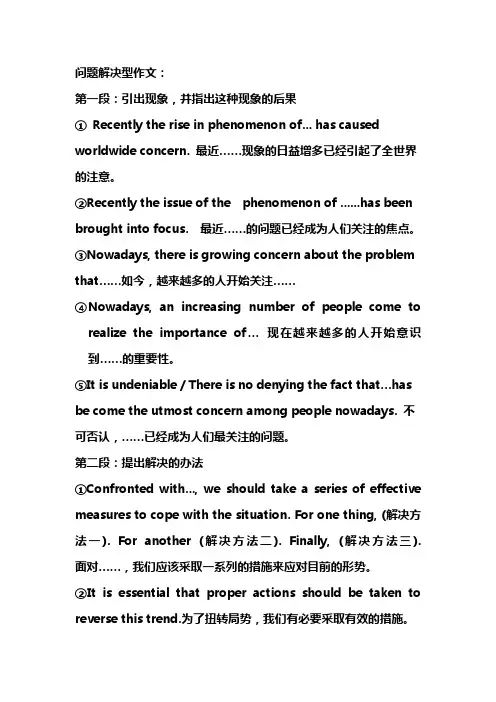
问题解决型作文:第一段:引出现象,并指出这种现象的后果① Recently the rise in phenomenon of... has caused worldwideconcern. 最近……现象的日益增多已经引起了全世界的注意。
②Recently the issue of the phenomenon of ......has beenbrought into focus. 最近……的问题已经成为人们关注的焦点。
③Nowadays, there is growing concern about the problemthat……如今,越来越多的人开始关注……④Nowadays, an increasing number of people come to realize theimportance of…现在越来越多的人开始意识到……的重要性。
⑤It is undeniable/There is no denying the fact that…has become the utmost concern among people nowadays. 不可否认,……已经成为人们最关注的问题。
第二段:提出解决的办法①Confronted with..., we should take a series of effectivemeasures to cope with the situation. For one thing, (解决方法一). For another (解决方法二). Finally, (解决方法三). 面对……,我们应该采取一系列的措施来应对目前的形势。
②It is essential that proper actions should be taken toreverse this trend.为了扭转局势,我们有必要采取有效的措施。
第三段:总结这样做的好处Only in this way can we…只有这样,我们才能…...cannot be overemphasized ......无论如何强调都不为过If one can really put the three points into action如果能实践这三点有直接关系:be directly related to重视:attach great importance to...必然趋势:an irresistible trend of在一定程度上:to some extend连接词:First,moreover,Finally。
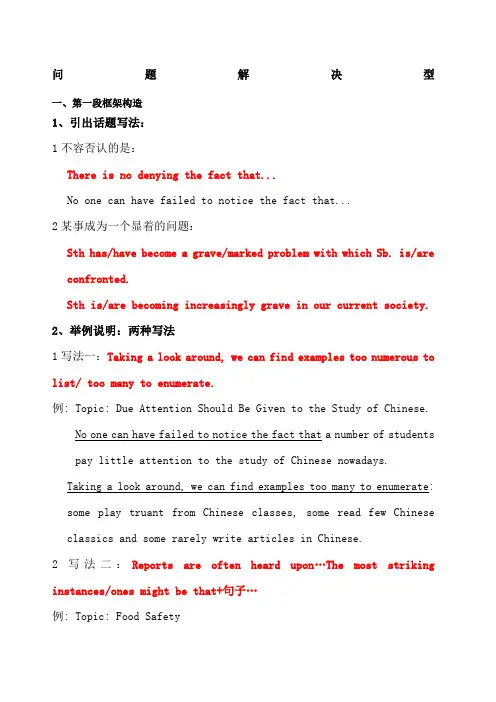
问题解决型一、第一段框架构造1、引出话题写法:1不容否认的是:There is no denying the fact that...No one can have failed to notice the fact that...2某事成为一个显着的问题:Sth has/have become a grave/marked problem with which Sb. is/are confronted.Sth is/are becoming increasingly grave in our current society.2、举例说明:两种写法1写法一:Taking a look around, we can find examples too numerous to list/ too many to enumerate.例: Topic: Due Attention Should Be Given to the Study of Chinese.No one can have failed to notice the fact that a number of students pay little attention to the study of Chinese nowadays.Taking a look around, we can find examples too many to enumerate: some play truant from Chinese classes, some read few Chinese classics and some rarely write articles in Chinese.2写法二:Reports are often heard upon…The most striking instances/ones might be that+句子…例: Topic: Food SafetyReports are often heard upon food products of bad quality. The most striking instances might be the San Lu milk powder, swill-cooked dirty oil and the so-called “lean meat powder”.3、再次强调中心:可有可无Actually, the problem has become so widespread that it has severely affected Sb’s life and hindered the development of …例: Topic: College Students’ Mental HealthThere is no denying the fact that mental health is of great importance to college students. Nowadays, many students in college suffer from mental illness, which severely affects their life and study. 背景交代Taking a look around, we can find examples too numerous to list. The most striking ones might be that some students committed suicide or murdered their roommates. Typical examples include the case of Ma Jiajue and that of a girl stabbing her schoolmates.举例论证二、第二段框架构造:原因分析段1. 中心句:有很多原因导致/来解释这个现象/问题,但主要有以下几个原因:1 A number of factors can account for this/such socialphenomenon/issue,but the following might be/ are the most critical ones.2There are several reasons for this social phenomenon/issue, but in general, they come down to three majors ones.3 A variety of factors contribute to this social phenomenon/issue,but…might be the leading reasons.2.解释具体原因:1 To begin with, ... Furthermore, ... Last but not least, ...2 For one thing…For another…/On the one hand, … On the other hand, …例: Topic: Due Attention Should Be Given to the Study of Chinese.A number of factors can account for such phenomenon, but thefollowing might be the critical ones.For one thing, the craze for learning English, to some degree, affec t students’ passion for the study of their native language.For another, the increasing emphasis on some so-called “practical subjects” closely related to job hunting also cut into students’ time and energy spent on the study of Chinese.三、第三段框架构造:后果描述段一写法一:The problem mentioned above is bound to/is sure to generate severe/unfavorable consequences if we keep turning a blind eye to /continue to losing sight of it.In the first place… what is worse…例: Topic: Due Attention Should Be Given to the Study of Chinese.The problem mentioned above is bound to generate severe/unfavorable consequences if we keep turning a blind eye to it.In the first place, students’ weakness in Chinese would give rise to their ignorance of Chinese culture.What's worse, their problems with Chinese would also hamper their study of other subjects.二写法二:As a result,…/ConsequentlyMeanwhile,…/ At the same time例: Topic: Say No to Pirated ProductsAs a result, intellectual property rights are severely infringed upon. Honest producers will lose the motivation to develop new products.Meanwhile, pirated products are often of low quality, thus damaging the interest of buyers.四、第四段框架构造:建议措施段1.中心句:1To cope with the problem, effective and immediate measures are supposed to be taken into serious account/consideration./effective measures should be taken.2 In view of /Considering/In terms of/Given the seriousness of theissue, effective measures/steps must be taken before things get worse.2.提出具体建议措施:1First and foremost,…Moreover,…In addition,…2 For one thing…For another…3In the first place…In the second place…3.总结与展望:结尾加分亮点1 Only with these measures taken can we expect a bright/promisingfuture of this nation.2 With these measures taken, it is reasonable for us to believethat the problem will be solved in the near future.例: Topic: Due Attention Should Be Given to the Study of Chinese.In view of the seriousness of the problem, effective measures must be taken before things get worse.In the first place, it is essential that the school attach more importance to the teaching of Chinese.In the second place, students should enhance their awareness of the importance of mastering their mother tongue.Only with these measures taken can we expect the all-sided development of students.具体建议措施:供参考1.政府:1制定法律法规It is high time that relevant laws and regulations were/shouled be worked out/established and rigidly enforced/implemented by authorities to limit 限制/ban禁止…The government should pay more attention to establishment of relevant laws and regulations, which can be used to standardize people's behavior.2加强管制,处罚违规者The government should strengthen control and severely punish those who break the law.2. 学校:加强…….的教育It is essential that the school attach more importance to the teaching of …Lectures on…should be frequently given to students to prevent problems from happening/ to foster sb’ interests on…3.个人:提高......意识It is also essential that a deep-going, widespread and ever-lasting campaign should be launched to enhance people’s awareness of …例: : Fire Accidents in Big CitiesIn view of the seriousness of this problem, effective measures must be taken before things get worse.First and foremost, it is essential that laws and regulations be worked out and enforced to ban behaviors leading to fires.Furthermore, the public should enhance their awareness of preventing fires and protecting themselves.Only with these measures taken can we expect a promising future of this nation.: College Students’ Job HuntingIn view of the seriousness of the problem, effective measures must be taken before things get worse.For one thing, it is essential that the government create more job opportunities by all means.For another, graduates should change their attitude towards employment and go to work in small cities and the country.With these measures taken, we have reasons to believe that the problem can be solved in the near future.: College Students’ Mental HealthIn view of the seriousness of the situation, effective measures must be taken before things get worse.Therefore, due attention has to be paid by colleges to students’ mental healthFirst and foremost, lectures on psychological health should be frequently given to students to prevent problems from happening.Secondly, psychological clinics should be set up to provide troubled students with timely help.As to students, we should keep the channel of communication open among ourselves and between us and our teachers and parents.Besides, in case of mental illness, we should not hesitate to go to psychological counselors for help.Only with these measures taken can we expect sound growth of college students.展望。
四级作文问题解决型模板英文回答:In the realm of problem-solving, a comprehensive approach often proves to be the most effective. By identifying the root cause, brainstorming potential solutions, and implementing a plan of action, we can navigate challenges and achieve desired outcomes.1. Identify the Root Cause:Analyze the situation to determine the underlying factors that have contributed to the problem.Conduct research, consult with experts, and consider multiple perspectives to gain a thorough understanding of the issue.Clearly define the problem in specific, measurable, achievable, relevant, and time-bound (SMART) terms.2. Brainstorm Potential Solutions:Generate a wide range of possible solutions without judgment or censorship.Encourage creative thinking and welcome unconventional ideas.Prioritize solutions based on their feasibility, effectiveness, and potential impact.3. Implement a Plan of Action:Develop a step-by-step plan that outlines theactions necessary to implement the chosen solution.Assign responsibilities and timelines to ensure accountability and progress tracking.Monitor progress regularly and make adjustments as needed to maintain momentum and achieve the desired outcome.中文回答:一、识别问题根源。
问题解决型模板(12句作文法)【模板一】Topic描述背景段①Until recently/ For years, 问题相关事物 has been regarded/ viewed 一些人的看法(,but不同的看法或情况). ②There are too many examples, (such as 相关事例,) to be listed individually.③现象/问题表现.说明危害/原因段④There are many facts accounting for 该问题/ Increasing public attention should be paid to that 该问题 is/ are exerting a harmful destructive effect on 危害主要对象. ⑤On the one hand, 危害一/原因一. ⑥On the other hand, 危害二/原因二.⑦Therefore, it is high time that we laid considerable special emphasis on 该问题.说明方法段⑧Above all/ First of all, 方法一. ⑨进一步阐述方法一. ⑩Moreover, 方法二. 11.Besides/ In addition, 方法三. 12.Only in this way can we解决问题.Topic描述背景段①In recent years, increasingly growing numbers of people 关注/牵涉/参与不良现象或问题. ②It is obvious that 危害一/作用一. ③Additiona lly, 危害二/作用二. ④Therefore, there is no denying that special/ considerable attention must be devoted to 该问题.说明方法段⑤On the one hand / Firstly, 方法一/因素一. ⑥进一步阐述方法一/因素一. ⑦On the other hand / Secondly, 方法二/因素二.⑧For example, 支持该方法的例子. ⑨In addition / Thirdly, 方法三/因素三.总结观点段⑩Of course, following these suggestions/ methods may not guarantee the settlement of 该问题, but the pay-off will be worth the effort. 11.As for me, 我的思考或看法. 12.Only by 途径, 倒装句总结全文./ Undoubtedly, it is necessary that 根本途径.Topic描述图表/背景段①Perhaps nothing is more dominant/ harmful/ dangerous/ disastrous in 不良现象或问题存在的范围 than 不良现象或问题.②According to the chart/ graph/ table/ a recent study/ investigation/ poll/ survey, 问题危害一/不良表现一.③Additionally, 危害二/不良表现二. ④It is obvious that how to 解决问题 is worth our attention/ paying attention to.说明方法段⑤To begin with, 方法一. ⑥进一步说明方法. ⑦Secondly, 方法二. ⑧For instance, 支持方法二的例子. ⑨Last but not least, 方法三. ⑩Only in this way / by these measures can解决问题.总结观点段11.Of course, the solutions vary according to different situations. 12.Therefore, it is necessary for us to take a flexible measure to 解决问题.。
四级英语作文问题解决型万能模板问题解决型四级英语作文万能模板。
英文回答:Introduction。
State the problem clearly.Briefly summarize the causes and effects of the problem.Thesis statement: Clearly outline the solution to the problem.Body Paragraph 1。
Describe the first aspect of the solution in detail.Provide specific examples and evidence to support yourargument.Explain how this aspect will contribute to solving the problem.Body Paragraph 2。
Describe the second aspect of the solution in detail.Provide specific examples and evidence to support your argument.Explain how this aspect will contribute to solving the problem.Body Paragraph 3 (Optional)。
Describe any additional aspects of the solution as necessary.Provide specific examples and evidence to support your argument.Explain how this aspect will contribute to solving the problem.Conclusion。
问题解决类英语作文好句英文回答:Problem-solving is a crucial skill in life, both personally and professionally. It involves identifying a problem, analyzing its causes, and developing and implementing effective solutions. In the face of challenges, problem-solving enables us to overcome obstacles, make informed decisions, and achieve our goals.To effectively solve problems, it is essential to adopt a structured approach. This typically involves defining the problem clearly, gathering relevant information, brainstorming possible solutions, evaluating the pros and cons of each solution, and selecting and implementing the most appropriate solution. Throughout the process, critical thinking, creativity, and perseverance are paramount.Problem-solving is not always straightforward; setbacks and frustrations are inevitable. However, it is importantto remain resilient and view these challenges as opportunities for learning and growth. By reflecting on our experiences and adapting our strategies, we can enhance our problem-solving abilities and become more effective in addressing future challenges.Moreover, problem-solving is not an isolated endeavor; it often requires collaboration and teamwork. By leveraging the diverse perspectives and expertise of others, we can gain valuable insights and develop more comprehensive solutions. Open communication, active listening, and a willingness to compromise are essential for effective teamwork in problem-solving.In the realm of business, problem-solving is a core competency. Organizations that excel at problem-solving are better equipped to adapt to changing market conditions, innovate new products and services, and satisfy customer needs. By cultivating a culture of problem-solving and empowering employees to take ownership of their work, businesses can foster a dynamic and responsive environment that drives success.Ultimately, problem-solving is an essential life skill that empowers us to navigate the complexities of life, achieve our goals, and contribute to a better world. By embracing a systematic approach, fostering a growth mindset, and seeking collaboration, we can develop our problem-solving abilities and become effective problem-solvers inall aspects of life.中文回答:问题解决是一个重要的生活技巧,无论是在个人层面还是在职业层面。
问题解决型作文常用句型
一、引出话题的常用句型
1.Nowadays, …has become a problem we have to face.
2.Although….has brought convenience to us, many people have begun to realize that it is the
source of trouble as well.
3.Recently, the issue/problem/question of…has been brought into focus/ brought to public
attention/posed among public attention.
4.With the increasingly rapid economic globalization and urbanization, more problems are
brought to our attention.
5.Thanks to China’s reform and opening-up policy, the past two decades have witnessed great
economic development and social transformation. However, …
6.It is undeniable/There is no denying the fact that…has become the utmost concern among
people nowadays.
7.In recent years, many cities/nations/people have been faced/troubled with the serious
problem of …
二、分析原因的常用句型
1.Here are many/several/a number of/ a variety of reasons for it. First, ….second, ….
Finally….
2.What has possibly contributed to this problem? In the first place…In the second place….
3.The explanation for this phenomenon involves many complex reasons. For one thing,….For
another….
4. A number of factors could account for/ lead to/ contribute to/ result in…
5.Some people may think that…is to blame for this problem, but its causes go still/far deeper.
6.what has possibly contributed to this problem? In the first place…In the second place…
三、提出解决方案的常用句型
1.It is important that effective actions should be taken to prevent the situation.
2.There is little doubt that serious attention must be called to…
3.There is no immediate solution to the problem of…,but …might be helpful/ but the general
awareness of the necessity of…might be the first step.
4.In order to make our world a better place in which we live, we should make great efforts
to…
5.confronted with…, we should take a series of effective measures to cope with the situation.
For one thing, … For another,… Finally…
6.The first key factor to solve this problem is…Another key factor is…
7.Faced with…, we should take a series of effective measures to cope with the situation.
8.It is high time that…Here are a few examples of some of the measures that might be taken
immediately.
9.There is no easy/immediate solution/approach to the issue of…, but…might be
beneficial/helpful.
四、评价解决方案句型
1. To conclude, we can see the best way is…
2. Following these methods may not guarantee the success in solution to…, but the payoff w ill
be worth the effort.
3. by doing ... you will ...;
4. …play a vital role in ...; it is effective to ...; as a result
模板一
Topic
⑴It is well-known that 相关背景, but nowadays 总述不良现象或问题. ⑵现象具体表现一.⑶现象的具体表现二.
⑷It should be paid attention to that 该现象is causing great harm/该现象is caused for many reasons. ⑸On one hand, 危害一/原因一. ⑹On the other hand, 危害二/原因二. ⑺Therefore, it is high time that 解决问题.
⑻First of all, 解决方法一. ⑼进一步阐述方法一. ⑽Secondly/In addition, 解决方法二.
⑾Thirdly/Besides/Morever, 解决方法三. ⑿Only in this way can we解决问题.
模板二
Topic
⑴There has been a discussion recently about 事实现象. ⑵ It is obvious that 危害一/作用一. ⑶Additionally, 危害二/作用二. ⑷So how to 解决问题 is worth paying attention to.
⑸On one hand/ Firstly, 解决方法一.⑹进一步阐述方法二⑺On the other hand/Secondly,解决方法二.⑻For example,支持该方法的例子. ⑼In addition/ Thirdly, 解决方法三.
⑽In fact, more than three ways can be adopted. ⑾As for me, 我的思考或看法. ⑿All in all, 总结全文.。